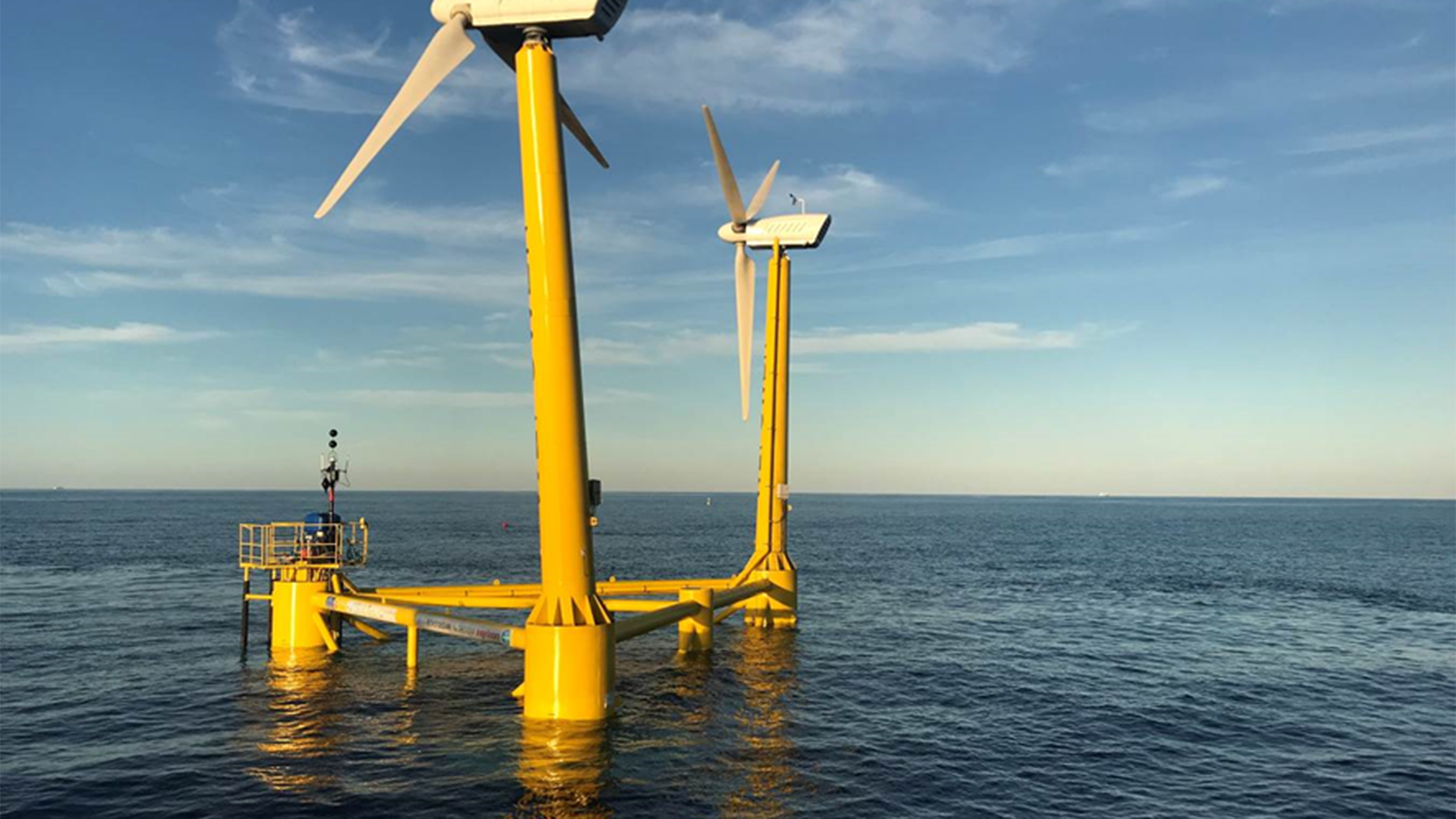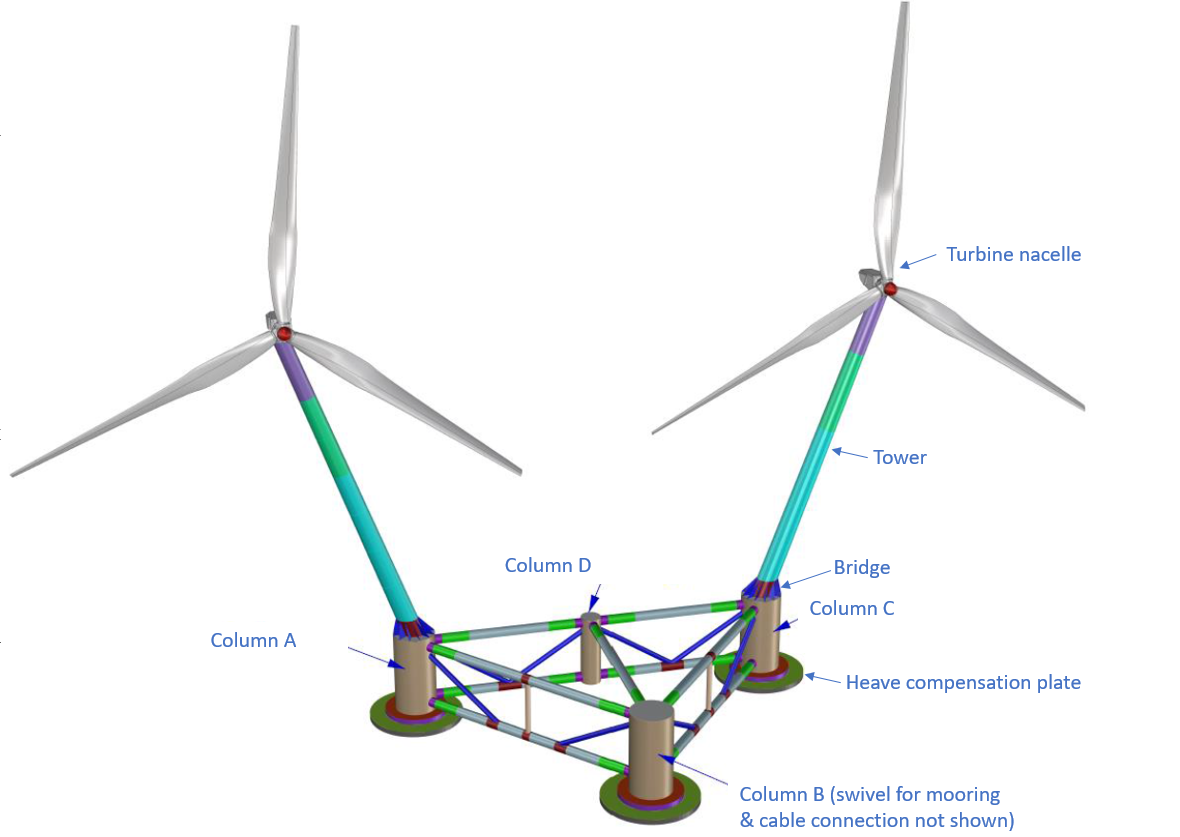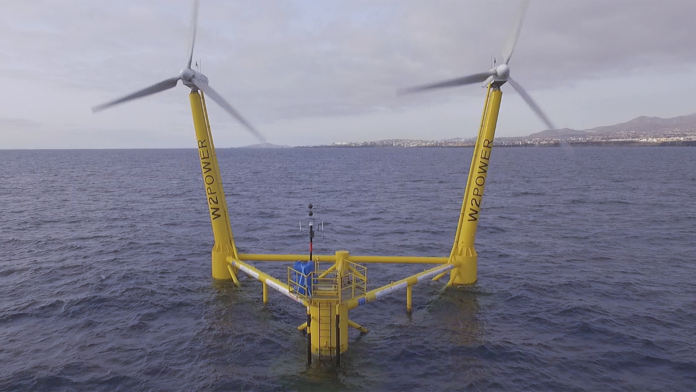After over a decade of thorough development, Enerocean’s W2Power floating wind power solution is set to be deployed across the globe by 2030.
Offshore wind power in recent years has been a success story, adding Gigawatts (GW) of new renewable power capacity each year. Offshore wind farms can access stronger and more stable winds at sea, as well as having less conflict for use of space than on land. The use of bottom-fixed foundations – mostly steel monopiles piled deep into the seabed – and wind turbines of ever greater size and power have driven costs to market parity in lead countries such as Denmark, the UK, Germany, Belgium, the Netherlands, and China.
However, the vast majority of countries worldwide lack large and windy sea areas shallow enough to build offshore wind farms by conventional methods. Neither monopiles nor other fixed foundations have much economic prospect in seas deeper than 40 to 50m, because their need for construction material and, consequently, cost increases proportionately with depth. Spreading the success of offshore wind power beyond shallow waters of the southern North Sea, its adjoining seas, and the East China Sea requires floating solutions. It is unsurprising that floating wind, long seen as a far-future prospect, has entered the mainstream focus of energy business managers, investors and policymakers as important tools for reaching ever-more ambitious decarbonisation goals.
Floating, therefore, is the key enabler for making offshore wind power generation truly global. But floating will only realise its potential if it is cost-competitive with other renewable technologies. For many countries, this is onshore wind, while for countries that have both shallow and deep seas – notably France, the US, and China – the benchmark is likely to be bottom-fixed offshore wind.
Floating wind power is not a new idea – serious engineering efforts on designing floating wind technologies go back at least 30 years.1 In the mid-2000s, many observers expected floating to blaze a rapid path to market as early designs entered sea trials. However, in the real world, the high cost of prototypes, failed full-size demonstrations such as Japan’s Fukushima FORWARD project, and, above all, the late but definite maturing of bottom-fixed offshore wind farms (whose cost have dropped by more than half since 2015) prevented this from happening.
W2Power floating wind power solution
W2Power is a mature, robust, and cost-efficient floating wind power solution suitable for any offshore sites from 50m to beyond 1000m depth. It has unique technical advantages that offer the prospect of reducing the cost-efficiency of floating to approach or surpass that of conventional offshore wind.
The W2Power floating solution has been in continuous development over more than a decade since its patenting2 and subsequent market introduction as a concept,3 both in 2009. Owned by Spanish company Enerocean, its lead developer since 2012, the technology has been refined and engineered, advancing systematically up the Technology Readiness Level (TRL) scale. Funded by a string of EU and National R&D projects, it has completed multiple design revisions, wave-tank testing, and component and subsystem improvements which allowed TRL 5 to be reached in June 2015.4

W2Power achieved TRL 6 by successful deployment in the open sea. A fully functional prototype completed four months at sea, closely monitored. The prototype being a 1:6 scale offers accelerated testing of survivability and, above all, fatigue damage to the structure. Its seaworthiness was proven by operating through seven storms of more than 4m waves – the highest waves of 5.3m – corresponding to >30m waves on a full-size platform, without any incident or need for intervention. The platform confirmed its excellent hydrodynamic behaviour and the simple tow-out, installation and mooring hook-up was proven. When the tests were completed, as planned and on schedule, the platform was towed back to yard and careful inspection showed no signs of damage.
The prototype remains at quayside, ready for new rounds of sea testing planned, among other objectives, to prove its multi-use properties.
Current status
It was recently observed by consultancy Wood Mackenzie that floating wind power needs to break the vicious circle of being more expensive than bottom-fixed, which prevents major buildouts of capacity as long as the cost premium of floating is perceived as too high by investors.5
Today, W2Power is the leading runner-up behind the four floating concepts that have reached higher technical – but not commercial – maturity: two spar-buoy technologies, Equinor’s Hywind, Principle Power’s WindFloat™ semisubmersible, and a barge by BW Ideol.
Many other floating technologies exist, at varying stages of maturity up to TRL 5. Some developers are expected to announce soon if their ongoing sea-testing campaigns are successful, as W2Power achieved in 2019. The increased cost of reaching TRL of 7 and above (full size installations, probably in arrays) has led to an increasing number of alliances being formed between developers and large energy players. One example is Enerocean’s investment and strategic collaboration agreement with Italy-based energy major Eni (Plenitude subsidiary) announced in April 2022.6
Technical = cost advantages
Whilst all other mature designs dedicate one floater to support each wind turbine, W2Power uses a pair of wind turbines whose nacelles are located beyond the area of the floating support (patent protected feature) to reach very high power ratings without a proportional increase in rotor diameter and need for construction steel. Using large, proven offshore turbines available from multiple original equipment manufacturers (OEMs) offers further advantages in turbine per-MW cost, reliability and market access compared to single-turbine floaters employing the latest 14 MW turbine designs. Current fully engineered forms of W2Power (see Fig. 2 below) are rated at 11 to 16 MW using a pair of 5.5 to 8 MW rated turbines with rotor diameters of up to 167m. This is a higher power rating than any other mature floating wind technology. Designs for next-generation 20+MW rated platforms are in progress.

The advantages of W2Power over competing solutions draw closely upon, and enhance, the principal advantages of the design. Key innovative features related to the floater structure, its optimisation for hydrodynamics as well as mass-manufacturing, mooring/station keeping, towers, control systems and condition monitoring all translate to lower cost per MW installed, by which criterion W2Power is the clear cost leader in floating wind. These cost advantages will be the subject of further articles in the same source planned for March and September 2023.
Pre-commercial full-size pilot deployment is in progress in the Canary Islands. The further pipeline includes commercial wind farms off the Iberian peninsula, the Mediterranean and other seas. Multi-GW deployment of W2Power worldwide is targeted for 2030.
References
- A Henderson et al. ‘Floating offshore wind farms – An option?’, paper presented at Offshore Wind Energy in Mediterranean and Other European Seas (OWEMES) conference, Siracusa, Sicily April 2000
- D Røyseth, ‘Floating, anchored installation for energy production’, EP 2 411 671 B1, priority date 23.03.2009
- All-Energy D Røyseth, R Hezari, Jan Erik Hanssen, W2Power: Combining wind and waves, Proc. 2009 All-Energy Conference & Exhibition, Aberdeen (Scotland) 17 May 2009
- J E Hanssen, Pedro Mayorga et al.: ‘Design and Performance Validation of a Hybrid Offshore Renewable Energy Platform’, presented at 10th International Conference on Ecological Vehicles & Renewable Energies EVER-2015, Monte-Carlo (Monaco) 31 March – 2 April 2015)
- S Lassen and F Clark ‘Floating wind: what will you be competing with and what will you be competing on?’ Wood Mackenzie report June 2022.
- Offshore Engineer,’Eni’s Plenitude to invest in Spanish floating wind tech company Enerocean’ 22.04.2022
Please note, this article will also appear in the eleventh edition of our quarterly publication.







